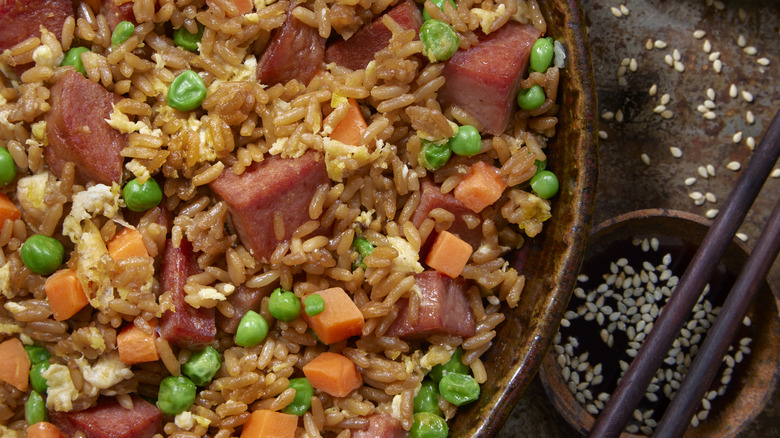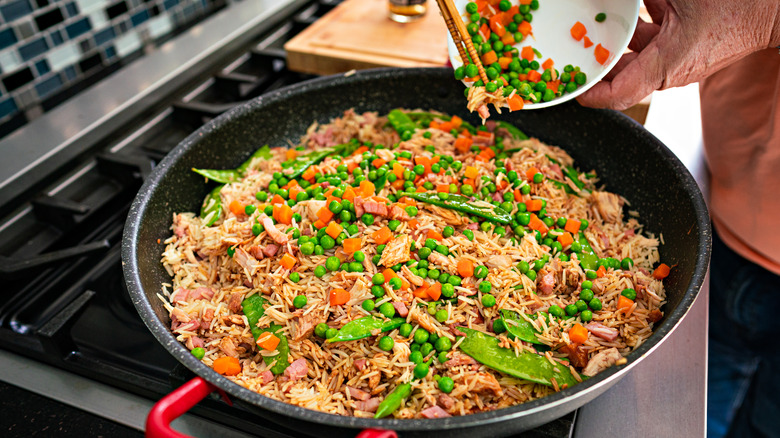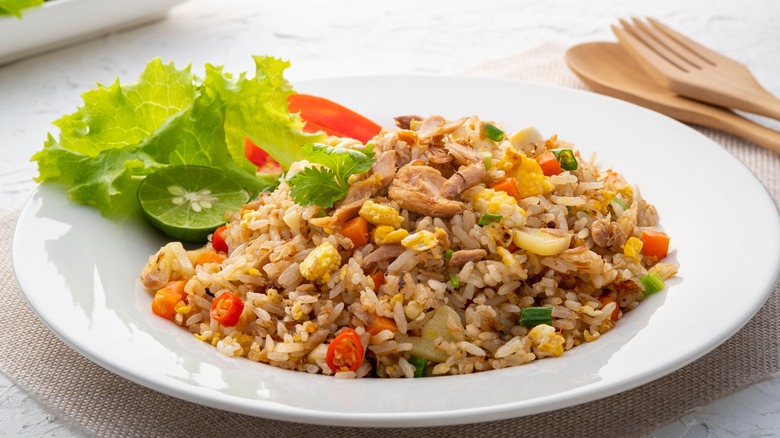The Top Tip To Follow For Sizzling Restaurant-Quality Fried Rice
From a simple side to a complete entree, mastering restaurant-quality fried rice from the home kitchen may be easier than it seems. Even though balanced seasonings are vital, the reality is that cold, day-old leftover rice — or otherwise not fresh from the rice cooker — is surprisingly the key to a better final product.
Sometimes a cooking hack can seem counterintuitive. Chefs often stress the importance of using the freshest ingredients, but that scenario is different for fried rice. The dish's texture is vital to overall eating enjoyment. Cold, previously cooked rice has had the opportunity to lose some of its additional moisture. Instead of that stickiness, which is great for other dishes, fried rice needs each grain to stand on its own. That scenario happens when it has had time to dry out a little.
Once the rice hits the pan with the other ingredients, seasonings, and sauces, it can absorb those additional flavors yet still maintain its structural integrity. The day-old rice has lost some of its moisture, which allows it to be infused with new flavor. The final product is a slightly toothsome, satisfying forkful.
No day old rice for fried rice, try this time saving hack
Since rice with too much moisture can ruin a great fried rice, getting the ingredients a little drier is a must. If freshly made rice is the only option, there are a few ways to dry it out so you can still make a bomb fried version. First, consider spreading out the rice on a sheet pan as it cools. By giving the rice more surface area, the temperature will come down more quickly. Second, by spreading it on the sheet pan, that pesky moisture will evaporate as it cools.
Lastly, the sheet pan can also be placed in the refrigerator to help speed up the cooling process. The chilly temps will not only stop any further cooking, but the refrigerator can also help to dehydrate the rice further. While some people recommend a freezer or blast chiller, any change in temperature can work. The idea is to stop the cooking process, not to make ice-rice. Even though making fried rice is quick, patience during the process is a virtue that benefits the final product.
Which rice should you use for fried rice?
While day-old rice makes for the best starting ingredient, choosing the right rice before that grain even hits the pan is equally as important. Long grain, Jasmine, brown, and Basmati are some of the different types of rice available to choose from. Since better fried rice needs separate grains and not a clumpy mess,long-grain rice is preferred for this type of dish. It has less starch, which prevents the grains from becoming sticky or clumpy when they cook. Jasmine, a type of long-grain rice, is a popular choice because of its texture, taste, and aroma.
To ensure the long-grain rice retains its structural integrity, it should be well-rinsed to remove excess starch and cooked carefully to avoid breakage. Swapping water for another cooking liquid can enhance flavor and keep the individual grains from sticking together, too. For example, coconut milk adds depth and helps to keep the rice from becoming too mushy.
In the end, restaurant-quality fried rice can be made on the home stovetop. The secrets to mastering the dish might not be found in a fortune cookie, but the time-tested hack of using leftover grains should be appreciated.


